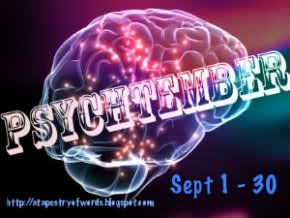One thing I've noticed with many YA books is that when a character has a mental illness, the whole story becomes focused around that aspect and it turns into an "issue book." Do you think this is helpful, or would it be beneficial to have more stories that feature teens that just happen to have mental illnesses? Why?
I think “issue books” often do a nice job of showing what
it’s like to deal with a psychological problem, which benefits teens who are
dealing with a mental health issue in their own lives, or in the life of a
friend or family member. As our ability to recognize and talk about
psychological issues has expanded (and as diagnostic criteria have expanded),
we’ve become more aware of psychological problems that used to get misdiagnosed
or swept under the proverbial carpet. Even people who have not been directly
impacted by a psychological disorder can benefit, because we all are bombarded
with TV shows, movies, and even cartoons that make assumptions (many of them
wrong) about what someone with such a disorder is like. Getting an insider’s
point of view makes us more empathetic.
I do like stories that address psychological problems without making said problems the axis on which the story turns, however. Though many people with undiagnosed or newly diagnosed problems are consumed by the disorder that’s bogging them down, many, many people learn to manage their diagnoses. The diagnosis then becomes an ongoing part of their lives, but not by any means the thing that defines them.
In other words, when someone is first diagnosed with something like ADHD or bipolar disorder (manic depression) or panic attacks, they may go through a stage of using the diagnosis as part of their identity. For example, they may say to people, “I’m bipolar,” or “One of my prominent characteristics is my ADHD,” or “I really have to think about my panic attacks before I can do anything else.” But just like teens with epilepsy or diabetes learn to adapt and make dealing with the problem part of their daily routine, so too do many people with psychological problems. And I’m not sure that’s portrayed often enough in fiction—people coping with their problems.
Granted, stories are more exciting when there’s drama and
conflict, but the period when someone is first diagnosed isn’t the only time
that things can be shaken up! For example, someone who has learned to manage a
disorder must also learn if, when, and how they are going to tell others. For
example, when and how does a 17-year-old girl who’s trying to impress her new
boyfriend tell him she has a problem with bipolar disorder? There’s still a
great deal of stigma toward mental illness, and it is usually much harder to
say “I have manic depression” than it is to say “I get migraines” or “I have
diabetes.” She will probably worry about how her boyfriend is going to take it,
whether he’s going to think she’s “crazy” for having to take meds and visit a
psychiatrist, whether he’ll tell other people. And even if he handles it well,
what if his parents disapprove? And what’s he going to do the first time he
sees actual symptoms? Will he be supportive, demeaning, afraid, angry?
In addition to that, her lifestyle may not mesh with her
peers’ expectations. She may not be able to stay up all night, sleep irregular
hours, eat like her body is a garbage disposal, let her blood sugar drop too
low, use popular remedies (like appetite suppressants, high-caffeine drinks, or
over-the-counter-cold medicine), or drink alcohol. (Yes, 17 is under the legal
drinking age, but we know that many teens experiment before that.) Things like
this can trigger bipolar episodes or exacerbate symptoms.
Also remember that stressors can aggravate many psychological conditions, so even a character who normally deals well can be thrown off track by a breakup, changing schools, or a parental divorce.
Finally, I
think a lot of authors do extensive research to try to understand a disorder
they want to portray, and we all know how tempting it is to use everything
we’ve learned! But sometimes a light touch is best. You can, like I said above, remind yourself that the
disorder is a part of the person’s life, something that needs to be managed,
not something that defines him or her.
I have a character who has panic attacks in social situations that involve pressure. This isn’t a huge part of the novel, and I never even name the problem (i.e. panic attacks). Instead, I just show him doing his best to deal with each attack as it comes. In a good novel, a vulnerability like this really should flare up and cause problems at a crucial moment, but again, it doesn’t need to define the character or the novel.
Carolyn Kaufman, PsyD's book, THE WRITER'S GUIDE TO PSYCHOLOGY: How to Write Accurately About Psychological Disorders, Clinical Treatment, and Human Behavior helps writers avoid common misconceptions and inaccuracies and "get the psych right" in their stories. You can learn more about The Writer's Guide to Psychology, check out Dr. K's blog on Psychology Today, or follow her on Facebook!
Thanks very much, Carolyn, for this insightful look at how to write a character with mental illness without turning the story into an "issue book"!
Readers — do you like it when a book zeroes in on a particular mental health issue, or do you prefer to see stories where it's there, but not the main focal point? Can you recommend some YA books that aren't "issue books" but still accurately portray a character with a mental illness?


























